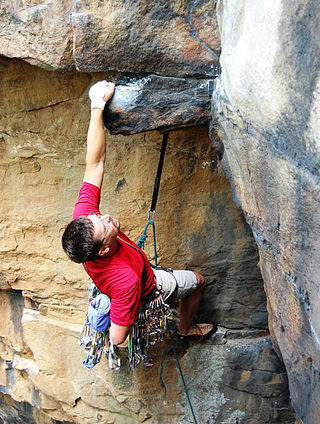
Traditional climbing is a style of rock climbing in which the climber places all the necessary protection gear required to arrest any falls as they are climbing, and then removes it when the pitch is complete. Traditional bolted aid climbing means the bolts were placed while on lead and/or with hand drills. Traditional climbing carries a higher level of risk than bolted sport climbing, as the climber may not have placed the safety equipment correctly while trying to ascend the route, or – in some cases – there may be no protection available to keep a climber from a ground fall or serious injury. For some of the world's hardest climbs, there may not be sufficient cracks or features in the rock that can accept protection gear, and the climb can only be safely attempted by bolting as a sport climb.

Sport climbing is a form of rock climbing that relies on permanent anchors, permanently fixed into the rock for climber protection, in which a rope that is attached to the climber is clipped into the anchors to arrest a fall; it can also involve climbing short distances with a crash pad underneath as protection. This is in contrast to traditional climbing where climbers must place removable protection as they climb. Sport climbing usually involves lead climbing and toproping techniques, but free solo and deep-water solo climbing on sport routes is also sometimes possible.
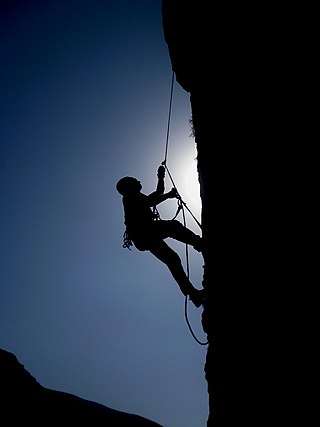
Rock climbing is a sport in which participants climb up, across, or down natural rock formations. The goal is to reach the summit of a formation or the endpoint of a usually pre-defined route without falling. Rock climbing is a physically and mentally demanding sport, one that often tests a climber's strength, endurance, agility and balance along with mental control. Knowledge of proper climbing techniques and the use of specialized climbing equipment is crucial for the safe completion of routes.
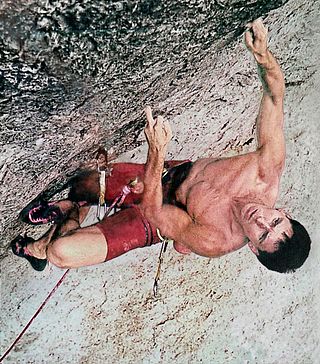
Wolfgang Güllich was a German rock climber, who is considered one of the greatest and most influential climbers in the history of the sport. Güllich dominated sport climbing after his 1984 ascent of Kanal im Rücken, the world's first-ever redpoint of an 8b (5.13d) route. He continued to set more "new hardest grade" breakthroughs than any other climber in sport climbing history, with Punks in the Gym in 1985, the world's first-ever 8b+ (5.14a), Wallstreet in 1987, the world's first-ever 8c (5.14b), and with Action Directe in 1991, the world's first-ever 9a (5.14d).
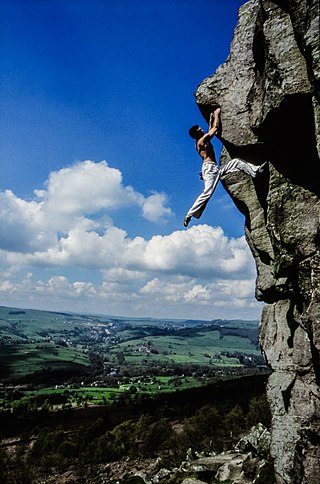
Jerry Moffatt, is a British rock climber and climbing author who is widely considered as being the best British rock climber from the early-1980s to the early-1990s, and was arguably the best rock climber in the world in the mid-1980s, and an important climber in the history of the sport.
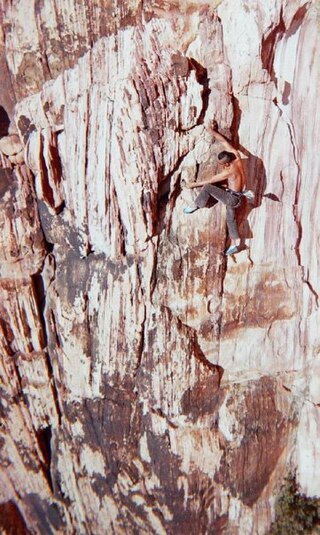
Free solo climbing, or free soloing, is a form of technical rock climbing where the climbers climb alone without ropes, or other protective equipment, only using their climbing shoes and their climbing chalk. Free soloing is the most dangerous form of climbing, and unlike bouldering, free soloists climb above safe heights, where a fall can be fatal. Though many climbers have free soloed climbing grades they are very comfortable on, only a tiny group free solo regularly, and at grades closer to the limit of their abilities.
In the sport of rock climbing, The Mandala is a 6-metre (20 ft) high bouldering problem in the Buttermilks, a popular bouldering area near Bishop, California. It is one of the most widely known boulder problems in the world, and is graded V12 (8A+).

Uli Biaho is a mountain near Trango Towers and Baltoro Glacier in the Gilgit–Baltistan area of Pakistan. It consists of two main peaks, Uli Biaho Tower ; and Uli Biaho Peak, which as of 2006 was unclimbed.
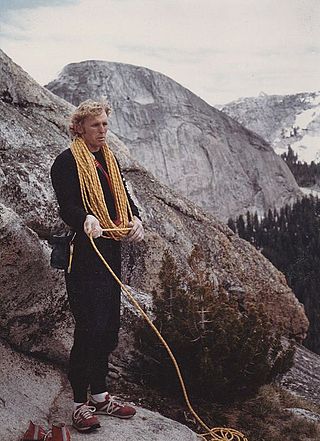
John Bachar was an American rock climber. Noted for his skill at free soloing, he ultimately died during a free solo climb. A fitness fanatic, he was the creator of the climbing training device known as the Bachar ladder.
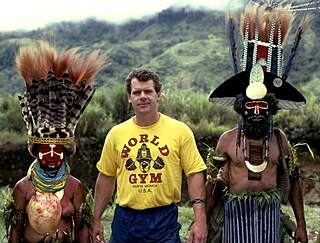
John Long is an American rock climber and author. His stories have been translated into many languages.

In the history of rock climbing, the three main sub-disciplines—bouldering, single-pitch climbing, and big wall climbing—can trace their origins to late 19th-century Europe. Bouldering started in Fontainebleau, and was advanced by Pierre Allain in the 1930s, and John Gill in the 1950s. Big wall climbing started in the Dolomites, and was spread across the Alps in the 1930s by climbers such as Emilio Comici and Riccardo Cassin, and in the 1950s by Walter Bonatti, before reaching Yosemite where it was led in the 1950s to 1970s by climbers such as Royal Robbins. Single-pitch climbing started pre-1900 in both the Lake District and in Saxony, and by the 1970s had spread widely with climbers such as Ron Fawcett (Britain), Bernd Arnold (Germany), Patrick Berhault (France), Ron Kauk and John Bachar (USA).
Beth Rodden is an American rock climber known for her ascents of hard single-pitch traditional climbing routes. She was the youngest woman to climb 5.14a (8b+) and is one of the only women in the world to have redpointed a 5.14c (8c+) traditional climbing graded climb. Rodden and fellow climber Tommy Caldwell were partners from 2000 to 2010, during which time they completed the second free ascent of The Nose. In 2008, Rodden made the first ascent of Meltdown, one of the hardest traditional climbs in the world and the first time in history that a female climber matched the peak of the highest climbing grades.

The Nose is one of the original technical climbing routes up El Capitan. Once considered impossible to climb, El Capitan is now the standard for big-wall climbing. It is recognized in the historic climbing text Fifty Classic Climbs of North America and considered a classic around the world.
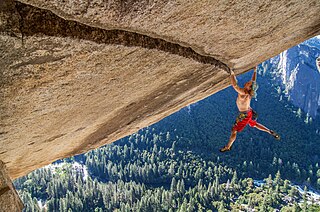
Separate Reality is a 66-foot (20 m) traditional climbing route in Yosemite National Park in California. The route is known for its exposed and dramatic crux that consists of a 20-foot (6.1 m) long crack in its horizontal roof. When it was first freed by Ron Kauk in 1978, it was one of the first climbs in the world to have a grade of 7a+ (5.12a). In 1986, German climber Wolfgang Güllich free soloed the route, and the photographs by Austrian Heinz Zak become iconic in rock climbing history.
John Roskelley is an American mountain climber and author from Spokane, Washington. He made first ascents and notable ascents of 7,000-meter and 8,000-meter peaks in Nepal, India, and Pakistan. In 2014, he became the 6th winner of the Piolet d'Or Lifetime Achievement Award.
Reinhard Karl was a German mountaineer, photographer and writer.
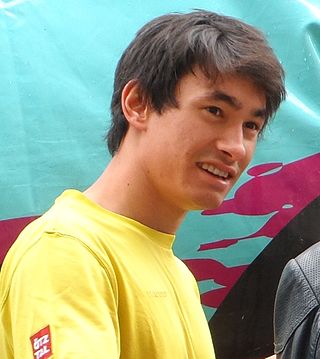
David Lama was an Austrian sport climber and mountaineer. He won the European Championship in bouldering in 2007 and the European Championship in lead climbing in 2006. He is known for his first free ascent of the Compressor Route on Cerro Torre. In 2018, in a solo expedition, he was the first to reach the summit of Lunag Ri in the Himalayas. In 2019, he was posthumously honoured with a Piolet d'Or for this first ascent.

Midnight Lightning is a 7.62-metre (25.0 ft) grade 7B+ (V8) bouldering problem on the granite Columbia Boulder in Camp 4 of Yosemite National Park. It is considered to be one of the world's most famous bouldering problems. Ron Kauk did the first ascent in 1978.
Hazel Findlay is a British traditional climber, sport climber and big wall climber. She was the first female British climber to climb a route graded E9, and a route graded 8c (5.14b). She did the third ascent of the Yosemite traditional route Magic Line 5.14c (8c+). She has free climbed El Capitán four times on four different routes and made many first female ascents on other routes. Climbing magazine gave her their Golden Piton award for traditional climbing in 2013.















